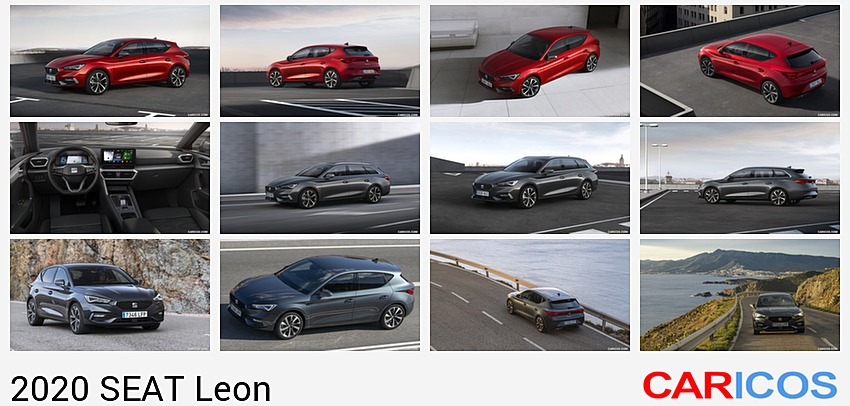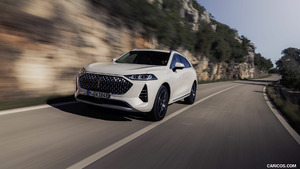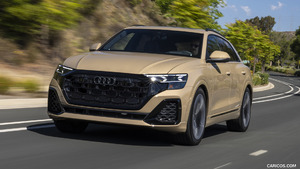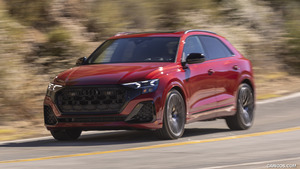2020 SEAT Leon
“The SEAT Leon has been improving generation after generation being able to conquer new customers. In 2019, the Leon has been the best-selling car for SEAT with more than 150,900 vehicles delivered, as well as best-selling car in Spain during the past 5 years,” said SEAT’s Executive Vice-president for Sales and marketing and CUPRA CEO, Wayne Griffiths. “We have now created the best Leon ever. The new Leon has been designed keeping the “created in Barcelona” spirit and at the same time being the safest, most connected and with the widest range of engines the brand has ever seen. We believe we have all the ingredients to make of the new Leon a great choice not only for private customers but also for corporate fleets.”
The all-new SEAT Leon is the latest vehicle to be designed and developed at SEAT’s facilities in Martorell, with production also taking place on the site. The Leon has been one of the core pillars in the brand’s product range accumulating more than 2.2 million sales since its introduction in 1999. The fourth-generation SEAT Leon is designed to take the vehicle to a new level offering even greater levels of dynamism, efficiency, safety and appeal.
The market for compact vehicles is becoming increasingly competitive as global trends change the way vehicles are perceived and external pressures increase, but SEAT is meeting these aspects head on with the all-new Leon.
The vehicle brings a strong design evolution, with an exterior and interior language that gives more character to the vehicle, helped in no small part by its revised dimensions, overall proportions, its more determined face and a fresh appraoch to lighting technology – both inside and outside.
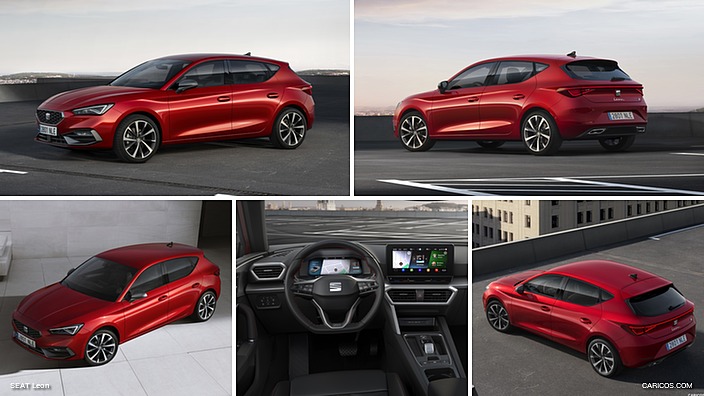 2020 SEAT Leon
2020 SEAT Leon
And as we enter an even more connected world, the next-generation SEAT Leon gives the consumer greater opportunity to take their digital lives with them into the vehicle, and also when they’re out of the car. The all-new SEAT Leon is the brand’s first fully connected vehicle, offering connectivity with Full Link - Android Auto and also wireless access to Apple’s CarPlay - and, online infotainment and will offer in-car apps in the near future that expand and improve the customer’s driving experience. Once out of the vehicle, users can access their vehicle’s data remotely and also manage the charging process and control the air conditioning remotely (in the case of the plug-in hybrid version).
A suite of new powertrain technologies; petrol (TSI), diesel (TDI), mild-hybrid (eTSI), plug-in hybrid (eHybrid) and Compressed Natural Gas (TGI), mean consumers can choose the vehicle that most closely matches their lifestyle and needs, while at the same time providing the efficiency and performance demanded by the market.
Safety is also at the heart of the all-new SEAT Leon. It integrates some of the most advanced driver assistance systems available, including predictive adaptive cruise control, emergency assist and travel assist, to make it the safest car the brand has ever made.
The advances to the all-new SEAT Leon have been achieved, in part, thanks to the vehicle’s MQB Evo architecture, providing the toolkit required to develop a vehicle that meets the many and varied needs of SEAT’s diverse customer base.
The all-new SEAT Leon epitomises the core values of the brand and its goal of offering the best vehicles possible, with the next-generation Leon, the compact segment is going to feel a transformative force when the vehicle is launched next month (April 2020).
Design: Enhanced overall dimensions and even bolder presence
“Although the all-new SEAT Leon is an evolution in our design language, it still presents itself as a bolder vehicle than the previous generation, and keeps hold of the brand’s DNA and the representative attributes of a Leon” said Alejandro Mesonero-Romanos, Director of Design at SEAT. “The exterior mixes the car’s key characteristics of confidence, elegance and sportiness.”
Exterior
With an exterior design that exudes confidence, elegance and sportiness, the all-new SEAT Leon benefits from well executed proportions.
The basis for the vehicle’s overall aesthetics is the advanced MQB Evo platform, which provided the dimensions, flexibility and adaptability the design team required, while the all-new SEAT Leon’s increased size for both the five-door and the Sportstourer brought an improved sense of proportions to the next-generation vehicle’s design.
The all-new SEAT Leon is 4,368mm long (+86mm) and 1,456mm high (-3mm) in its 5-door version, while the Sportstourer version is 4,642mm long (+93mm) and 1,448mm high (-3mm).
Both versions are 1,800mm wide (-16mm), with a wheelbase that stands at 2,686mm, 50mm more than the third generation SEAT Leon, making them extra roomier in the rear seats.
The all-new SEAT Leon builds on the appeal of its predecessor but with a stronger personality, helped by its smooth flowing surfaces and the perfect mix of edges and curves in the right places. And while the exterior aesthetics are what draws the eye, its style also enhances the vehicle’s overall efficiency with improved aerodynamics ; the all-new SEAT Leon’s drag co-efficient has improved by around 8% compared to the previous generation.
At the front of the all-new SEAT Leon, the design provides greater personality, with a stronger three-dimensional connection between the grille and front lighting. The LED headlights are set back, providing an eyebrow effect, giving a deeper focus and making it instantly recognisable to other road users.
The hood too, which is slightly longer than the previous generation, feeds into the vehicle’s more assertive design attitude and gives more verticality to the front-end, adding to the determined stance seen throughout the all-new Leon’s design. This can also be seen in the A-pillars, which have moved further rearwards to elongate the front proportions of the vehicle.
The surfaces of the all-new SEAT Leon have evolved, with stronger shapes, giving a more elegant design treatment, with more changes and nuances in the colour and tone of the vehicle as the light hits the paintwork and shifts across the body. This creates a vehicle with a multi-layered, shifting aesthetic.
The excitement and creativity continues at the rear of the all-new SEAT Leon. Emphasised by the coast-to-coast LED light and a boot designed to maintain the dynamic personality of the vehicle. Both the lighting system and spoiler create lines that generate the notion of speed, even when the car is not moving at all.
Interior
Inside, the all-new SEAT Leon’s design continues its evolutionary theme, but one that puts the driver and other occupants at the centre of its strategy.
The all-new SEAT Leon’s interior is the pinnacle of functionality, minimalism and sleekness from the moment you take your seat in the cabin behind the steering wheel – the main contact point between driver and car.
The smooth-surfaced, slim yet wide dashboard gives the impression of lightness, and a degree of “floatability”. The effect is created with the help of the decorative mouldings that surround the dashboard and continue through the front doors.
Everything in the cabin has been designed to be ergonomically precise, increasing interior comfort for ocuppants. Whether sitting in the driver’s seat, as a passenger or in the rear, the cabin is developed to fit the occupants like a glove, providing the feeling of security.
The interior’s main protagonist is its central 10” infotainment screen, which includes gesture recognition, delivering precise interaction with the occupants and reducing the number of physical buttons required. Its “diagonal” graphic design theme of the screen gets its inspiration from that important avenue of Barcelona, the Diagonal. It’s the first time that the design interface has been created in the new Digital Lab in SEAT, pioneer in its class.
Interior light is an important feature of the all-new Leon. It includes a wraparound ambient light that covers its entire width and continues through the doors. It’s not only an ambient decorative light, but it also provides a number of key functions such as blind spot detection or exit assist.
A lot of attention has been placed on achieving a perfect balance of refined and soft plastics, textiles and leathers to cover seats, doorpanels and the dashboard.
And the all-new SEAT Leon mixes its appealing design with practicality too. The 5-door SEAT Leon offers a boot capacity of 380 litres (identical to the previous generation), while the Sportstourer offers 620 litres of boot capacity (30 litres more than the previous generation).
Trims: Personalised to your needs
No matter which trim level is picked – Reference, Style, Xcellence or FR – the all-new SEAT Leon will offer everything the driver needs, and personalised to the highest level.
One of they key comfort features in the interior of the car is the 3-zone automatic air conditioner “Climatronic”, offering new levels of comfort for the passengers, whether seated in the front or in the rear of the car (standard equipment for FR and Xcellence trims).
Reference
Even in Reference trim the all-new SEAT Leon offers a range of standard equipment that sets it apart from the competition and gives it a competitive edge in the market.
Reference brings a standard fresh exterior look highlighted by the front LED headlights, rear full LED tail lamps and roof rails (Sportstourer), accompanied by 15” steel wheels, (16” steel and alloy options are available). Electric exterior mirrors and door handles all come in body colour. The rear window also includes a wiper.
Keyless Go brings simplicity, while inside the two front USB type C ports make connection to smart devices simple. A four-speaker infotainment system that uses an 8” screen brings multimedia and radio into the cabin aided by the inclusion of SEAT connect technology.
Comfort is assured with Climatronic, and drivers will always be able to find the optimum position with the driver height adjustment control. And with six airbags – two front, two front sides and two curtain – safety is assured. Additional equipment includes seatbelt reminders, ESC and tyre pressure warning indicator and an electronic parking brake.
Style
As well as the equipment found in the Reference trim, Style adds front and rear LED reading lights, a glovebox light, a leather multifunction steering wheel and leather gear knob, bluetooth, heated exterior mirrors and cruise control, adding to the vehicle’s convenience.
Comfort increases with the inclusion of driver lumbar adjustment and height adjustment in the passenger seat. 16” alloy wheels are standard with the optional upgrade to 17” rims also available.
Xcellence
Moving to the next level in SEAT’s trim options, Xcellence brings two rear USB type C ports so users can keep devices charged and introduces three zone Climatronic, front and rear armrests. The driver also benefits from the introduction of the SEAT Digital Cockpit, making all necessary information easily accessible, and giving the ability to customise what is displayed.
The interior also gains wraparound ambient lighting, Xcellence-specific colour and trim seats and a steering wheel embossed with the Xcellence logo and includes both the LED interior illumination pack, convenience pack and interior design pack.
Xcellence trim includes 17” alloy wheels, full LED rear lights including the rear coast-to-coast light, front LED fog lamps and cornering lights. Adding to the external look is the hot stamped diamond grille, chrome framed side windows (rear windows are also tinted), chromed roof rails, rear parking sensors and foldable exterior mirrors.
The Xcellence trim also adds lumbar adjustment for the passenger, illuminated aluminium door steps in the front doors and door panel illumination as well as an air clean filter.
FR
As well as all the standard equipment found in the other trim levels, FR adds specific bumpers, suspension, rear FR logo, specific 17” alloy wheels, (with the option of 18” wheels) and SEAT drive profiles.
The FR trim also brings full-LED technology to the rear of the vehicle including the coast-to-coast light, and LED indicators. Privacy and style are cemented with dark tinted windows, illuminated aluminium door steps in the front and door illumination.
The FR trim also adds front sports seats finished in sport textile, and an FR specific steering wheel with logo adding a more sporty character to the all-new Leon.
Lighting the way in the segment
The all-new SEAT Leon pushes the boundaries of what is possible in the segment with the range of lighting technologies integrated both in the outside as in the inside of the vehicle. SEAT’s engineers and designers have used advanced lighting systems to provide dynamic styling, bring focus to the overall design and improve safety.
The full LED technology used in the headlights improves vision, making even the darkest road visible to the driver, and incorporating SEAT’s signature LED lighting design, giving the all-new Leon the definitive SEAT face.
The vehicle’s side mirrors include integrated LED indicators, and on vehicles with the the full LED option include welcome lights that greet the driver and passengers projecting the word “Hola!” onto the ground as you activate the vehicle.
The all-new SEAT Leon’s design is emphasised further with the inclusion of the coast-to-coast light design. The technology gives greater expression to the rear and makes the vehicle standout to other road users. The all-new Leon also includes dynamic indicators making the vehicle’s direction of travel clearer and therefore safer. But it isn’t only on the vehicle’s exterior that the development team has used the flexibility and functionality of LED technology.
Inside, the next-generation SEAT Leon enhances the cabin experience with a full-LED wraparound ambient lighting system bringing increased personality to the interior.
The lighting sweeps around the front of the cabin, from the front doors and across the top of the dashboard, creating an arc of light that brings the Leon’s interior character to life.
The system changes the colour and brightness of the lighting depending on the needs. So whether you’ve just started the vehicle and enjoy the welcoming ceremony or shift drive profile from Eco to Sport mode, for example, the light system brings a new dynamic to vehicle-driver interaction.
Connectivity: The brand’s first fully connected vehicle
The world is changing, it’s more digitalised than ever before as we plug into the connected world. And the need to take this digital world with us into the vehicle is growing, which is why the all-new SEAT Leon is the brand’s first fully connected car.
At the heart of the Leon’s system there is its SEAT Digital Cockpit, which brings together a high-resolution 10.25” user definable instrument cluster and infotainment system. The standard Media system boasts an 8.25” screen with smartphone audio compatibility, while the larger 10” screen Navi system offers 3D connected navigation and natural voice control as well as gesture recognition to simplifiy user interaction.
Voice recognition is perhaps one of the easiest and most natural ways to interact with devices, especially as we have become increasingly used to home assistants from the consumer electronics world.
In the all-new SEAT voice recognition enables a natural understanding of language in order to allow the user to interact with the infotainment system using natural commands - the system responds by simply saying the international word “Hola” twice -, making corrections and referencing previous commands. So whether you need to find navigation information or search for music, it is quicker, easier and safer.
And with the Full Link system, customers will also be able to access their digital lives no matter what device they use; Apple CarPlay (using a wireless connection based on Bluetooth or WLAN) or Android Auto using a cabled connection.
The Full Link system is the gateway to connectivity, allowing users to connect their mobile devices to the vehicle’s infotainment system, and bring their digital eco-system into the vehicle. So whether you want to bring your contact list into the vehicle, the music that’s part of your journey or mapping systems, they are all available, accessed in a controlled, intuitive, safe manner that won’t distract drivers from the road, using either the infotainment system or the integrated steering wheel controls.
And with the optional Connectivity Box with inductive charging that meets Qi standard protocols, users needn’t worry about losing power at crucial moments.
The Online Connectivity Unit with an embedded SIM means that the all-new SEAT Leon will never lose its connection to the digital world, and, in future developments, the system will allow users to access the latest infotaniment apps which can be updated at any time. Therefore, the all-new SEAT Leon will be able to offer new digital products and services throughout its lifetime. The built-in eSIM also means that the SEAT Leon benefits from the eCall service, which directly contacts emergency services should an incident occur, adding yet another level of safety to the vehicle. It’s not only the possibility to make an emergency call (manual or automatic) but also that important data from the car will be sent to the emergency services such as car position, engine type, car colour or number of passenger, making it easier for them to assist.
In addition, the online connectivity via the embedded eSIM allows some infotainment functions to use real time information from the cloud, adding an additional dimension to the traditional navigation system. For example, online traffic information, parking and petrol station position and also the opening times and current prices. And, for those who don’t want to be limited to the radio they listen to, the all-new SEAT Leon brings online radio into the cabin, allowing the customer to listen to any online radio station they choose, even if it’s from a different country.
A new world is being opened up thanks to the SEAT Connect app which can be downloaded to your smart device, giving remote control over a plethora of functions that will help maximise the driver enjoyment and help improve safety too.
Once outside the vehicle, thanks to the SEAT Connect app, users can remotely access their vehicle’s data: driving data, parking position, vehicle’s status, including doors and lights, set up speed alerts so you can be warned if someone using your vehicles is driving too quickly, area and anti-theft alerts, open and close the doors with the remote lock and unlock service, or can remotely activate the horn and turn signals to find the car more easily. It doesn’t end there, with the introduction of the plug-in hybrid variant, additional features to help users have also been added. Plug-in hybrid vehicle drivers can manage the charging process remotely via the e-Manager, control the air conditioning and manage departure times all from the smartphone app.
The number of in-car and online services will grow through the life of the vehicle as the digital eco-system expands, enhancing the user experience.
Powertrains: Wide range of the most advanced engines
The all-new SEAT Leon has been developed with the real world in mind, with a range of powertrains that now also includes three electrified variants to boost efficiency even further. The new-generation compact car benefits from petrol (TSI), diesel (TDI), compressed natural gas (TGI), mild-hybrid (eTSI) and plug-in hybrid (eHybrid) units, each designed to deliver the highest levels of performance and driveability, giving customers the right combination of vehicle and engine to match their specific needs.
Models that use the DSG automatic transmission now benefit from shift-by-wire technology. The system is designed so that the gear selector is not connected to the gearbox mechanically, but using electronic signals to shift and to steer the parking lock.
The all-new SEAT Leon offers different predefined drive mode – Eco, Normal, Comfort and Sport – to the driver. With the individual drive mode, the driver is able to adapt the car to the personal needs, thanks to the new DCC slider.
Petrol
The new Leon’s offer of standard petrol engines are all direct-injection, turbocharged units and provide power outputs between 66kW/90PS and 140kW/190PS.
The two lower output engines which produce 66kW/90PS and 81kW/110PS of power are 1.0 litre TSI three-cylinder units, which are used in the SEAT Leon for the first time.
Available with power outputs 96kW/130PS and 110kW/150PS, the larger 1.5 litre petrol engines offer a level of performance that will bring a smile to the face of the driver but with the reassurance of optimised efficiency.
The two 1.0 TSI and also the 1.5 TSI 96kW/130PS engines use a Miller-cycle combustion process and variable geometry turbocharger to take efficiency to the next level in this displacement size engine.
The Miller-cycle optimises valvetrain control with early closure of the inlets combined with a higher compression rate and turbocharging to better control the air-fuel mixture, to improve efficiency by up to 10%.
The 1.5-litre units also integrate Active Cylinder Management to maximise efficiency. In some driving conditions, the engine works with only two cylinders to reduce the fuel consumption.
At the top of the tree is the 140kW/190PS 2.0 litre TSI unit always linked to the dual-clutch transmission.
Diesel
Diesel remains an important technology in reducing carbon emissions, and the all-new Leon benefits from two diesel options: all 2.0 litre TDI units.
The 5 doors and the Sportstourer versions have a manual transmission for the 85kW/115PS, while the 110kW/150PS diesel engines is offered with either manual or DSG automatic transmissions. The Sportstourer is also available with a 110kW/150PS unit mated to a DSG gearbox and 4Drive system.
The TDI units introduce a new twin dosing SCR system that includes dual AdBlue injection to reduce significantly NOx emissions compared to the Leon’s previous generation diesel engines. The result is a range of diesel engines that meet the strict requirement of the latest emissions standards.
mHEV
The all-new SEAT Leon also encompasses mild hybrid technology (eTSI), allowing the compact car to provide even greater efficiency levels. The system, which is available with the 1.0 TSI 81kW/110PS and the 1.5 litre 110kW/150PS petrol unit, both exclusively in combination with the DSG transmission, mates 48V mild-hybrid technology to the combustion engine, which not only adds the efficiency of electrification.
The technology uses a 48V starter-generator and 48V lithium-ion battery, and efficiency gains obtained, in part, because the system allows the Leon to coast with the engine switched off during some driving scenarios, recover energy under braking and supporting the engine with some electric assistance.
Plug-in hybrid
And as SEAT expands its use of electrification, the fourth-generation Leon also includes an advanced plug-in hybrid variant. Mating a 1.4 litre TSI petrol engine electric motor, 13kWh lithium-ion battery pack and six-speed DSG transmission, the setup produces 150kW/204PS of power.
The plug-in hybrid version also allows drivers to use electric only mode, giving a range of up to 60km (WLTP) using just the energy stored in the vehicle’s battery – perfect for increased efficiency, or to travel around city streets where air quality regulations are stricter.
The plug-in hybrid version will be offered on both the 5-door and Sportstourer versions.
CNG
The all-new SEAT Leon has the option of a CNG 1.5 litre TGI unit that produces 96kW/130PS of power.
The vehicle integrates 3 CNG tanks with a total net capacity of 17.3kg, giving the CNG-power all-new SEAT Leon an estimated CNG range of 440km without needing to refuel. And if the CNG tanks do run dry, the engine switches automatically to run on petrol until reaching the next CNG fuel station. Once there, it’s as simple to refuel as any other vehicle in the range.
Safety: The safest SEAT ever made introduces highly-developed assistance systems
“The all-new SEAT Leon has been designed and developed to be the most innovative product the brand ever made - besides its online connectivity it also offers state-of-the-art driving assistance systems. It inspires passion and awakens something inside people when they look at it, you just have to watch and let the vehicle convey its essence,” said Axel Andorff, Executive Vice-president for Research and Development at SEAT. “It is all about touching and feeling the new Leon.”
The all-new SEAT Leon is the safest vehicle the brand has ever developed; designed to see more of its surroundings and react to obstacles on the road or sudden movements by other drivers thanks to the integration of a suite of updated and completely new advanced driver assistance systems (ADAS).
The various technologies mean that the SEAT Leon senses its environment to offer the optimum protection no matter what scenario occurs when you’re behind the wheel, taking safety to the next level.
The all-new SEAT Leon brings together a range of new ADAS systems including Dynamic Chassis Control (DCC), predictive Adaptive Cruise Control (ACC), Emergency Assist, Travel Assist and Side and Exit assist, which, together can protect the vehicle and its occupants while driving or stationary.
Thanks to the all-new SEAT Leon’s DCC Dynamic Chassis Control, the vehicle’s ride and handling can change depending on the conditions and the driver’s requirements, making the vehicle more comfortable.
The adaptive chassis technology constantly reads the road conditions, while also taking into account steering input, braking and acceleration, to adapt the suspension, optimising damping at each wheel to provide comfort and dynamics like no other. And thanks to the new DCC slider, the setup of the chassis can be adjusted even more precisely.
Predictive adaptive cruise control (ACC) can position the Leon based on route and GPS data delivered from the navigation system, also allowing it to correct its speed depending on the road layout ahead – bends, roundabouts, junctions, speed limits and built-up areas. And using input from the front mounted camera and traffic sign recognition, it can adjust vehicle speed when limits change.
The automatic driving functionality will continue with the introduction of the Travel Assist feature in the near future. The system will use information from the ACC and Lane Assist to actively keep the vehicle in the centre of the lane and adjust speed to the flow of the traffic – providing assisted driving at speeds of up to 210km/h. The technology will also allow for overtaking; drivers need only switch on the indicator, and if traffic allows the vehicle will automatically conduct the maneouvre.
To maintain safety and to meet legal requirements the driver must maintain constant monitoring of the system and their surroundings, keeping at least one hand on the steering wheel. If the vehicle sensors they haven’t, (the steering wheel includes capacitive sensors) and they let go for more than 15 seconds, they will receive audible and visual warnings, and a braking jolt can be given. If the driver continues to fail to respond the Emergency Assist system can bring the Leon to a complete stop.
Another new addition to the all-new Leon’s safety suite is the Exit Warning. When stationary and opening a door, the vehicle will give an audible warning if traffic is coming – this can be other vehicles if on the road side, or cyclists or pedestrians if on the kerb side.
Heritage: The path towards the fourth generation
Since its introduction in 1999 the SEAT Leon has been one of the pillars of the brand, recording astounding sales numbers, introducing new technologies and bringing new levels of dynamism and design to an incredibly competitive segment.
All generations have been designed, developed and produced in Barcelona at the brand’s Martorell facilities. The SEAT Leon was named after the Spanish city Leon, a tradition at SEAT since 14 models have been named after a Spanish city (Ronda, Ibiza, Malaga, Marbella, Toledo, Inca, Alhambra, Cordoba, Arosa, Leon, Altea, Ateca, Arona and Tarraco).
The first-generation SEAT Leon, marked the brands entry to the C-segment in 1999, and sold more than 500,000 units. But it was also a car that brought a range of technologies with it; from its Haldex all-wheel drive system, (it was the first SEAT to mate all-wheel drive with fully independent multi-link suspension) six-speed transmission and a powerful 132kW/180PS engine.
The first-generation SEAT Leon was also the first of the brand’s hatch models to offer more than 147kW/200PS after the introduction of the Leon Cupra 2.8 V6 in 2000. An astonishing vehicle, with a V6 engine that produced 150kW/204PS.
By 2005 it was time for a new model and SEAT introduced the second-generation Leon. It had a challenge surpassing the success of the previous vehicle, but it did.
Not only did the second-generation usher in the introduction of electromechanical power steering, direct-injection technology, start&stop and an energy recovery alternator, it also boosted safety.
The Leon now benefitted from an improved ESP system, electronic locking of the EDS differential, an EBA system, and complemented by overboost technology that allowed maximum braking performance even with high disc temperatures. There was also a BSW system that cleaned the brakes when the windshield wiper was operated. Not forgetting the Driver Steering Recommendation, that helped maintain vehicle trajectory if an emergency occurred.
The vehicle also set up the next-generation CUPRA variant – the Leon CUPRA R, with its 194kW/265PS 2.0 litre TSI engine – a car that became the most powerful model in SEAT’s history at the time.
In total, over 675,000 second-generation SEAT Leons were sold, and it helped set the tone for the third-generation car, one that would set the bar even higher.
Introduced in 2012, the third generation of SEAT Leon was arguably the brand’s most technologically advanced vehicle to date offering a plethora of performance, efficiency and safety technology. All engines at launch included start& stop, it offered Full LED headlights, High-Beam Assist, Lane Control Assist, Fatigue Detection and all versions included seven airbags as standard. As well as these, it also integrated SEAT FullLink, boosting the brand’s connectivity options.
By July 2019 over a million units had been sold, cementing its place as one of the SEAT’s most successful vehicles.
And the success wasn’t found just in sales figures, but on the track too. In 2014, the Leon CUPRA SC (3-door version) with its 205kW/280PS four-cylinder TSI engine became the fastest front-wheel drive compact car to take on the famous Nurburgring Nordschleife circuit, going under the eight minute record with a time of 7:58.44 under the control of driver and ambassador Jordi Gené.

